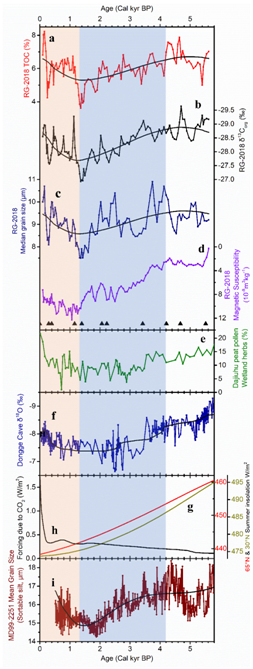Understanding the dynamics and variability of the paleo Asian Summer Monsoon (ASM) system is crucial to discuss spatiotemporal monsoon rainfall patterns in Asia and future climate projections. However, ambiguities exist because paleoclimate records currently lack sufficient geographic detail in ASM influenced regions, especially the eastern Tibetan Plateau (TP).
Recently, a study led by Prof. ZHOU Weijian from the Institute of Earth Environment of the Chinese Academy of Sciences (IEECAS) investigated a multi-parameter, absolute-dated lacustrine record from the eastern Tibetan Plateau (RG-2018; Fig. 1),which provided a continuous history of the Asian summer monsoon (ASM) over the past ~6000 years. Their study was published in Climate Dynamics.
They found that sediment properties (magnetic susceptibility, organic matter content, δ13Corg and grain size; Fig. 2) showed that climate was relatively warmer and wetter before ~4.2 ka BP. Climate conditions became gradually drier during ~4.2-1.3 ka BP.
RG-2018 record broadly followed the trend in northern hemisphere summer insolation over the past ~6000 years. However, it diverged during a period of increased moisture and thermal conditions during the past ~1300 years, broadly corresponding to the ASM "2-kyr shift". This shift as referred by CHENG et al. (Nature 534:640–646, 10.1038/nature18591, 2016) might be related to Atlantic Meridional Overturning Circulation variations, and potentially to increased forcing by greenhouse gases coincidented with reduced ENSO activity.
They observed several sub-millennial-scale weak monsoon intervals in the RG-2018 record, including the Little Ice Age centered at ~0.5 ka BP . Cross-correlation of the sub-millennial-scale monsoon precipitation record with the solar activity and ENSO records showed that most of the monsoon variability potentially resulted from changes in solar irradiation and was correlated with ENSO activity.
The RG-2018 record confirmed the theory that ASM responded rapidly to changes in solar irradiation through atmospheric processes. Internal feedbacks like the meridional migration of the ITCZ and the east-west displacement of the Walker circulation might be pivotal in enlarging these minor external fluctuations.

Fig. 1. Geological setting of the study site (red solid star, Lake Ruogen Co, 30°9′N, 99°44′E; 4315m).(a) Averaged atmospheric flow fields at the 850 hPa isobar in summer (JJA) from 1971 to 2010. Triangles indicate other records mentioned in the text. The grey shaded area indicates the region where elevations exceed 3000 meters (i.e. the Tibetan Plateau);(b) Meteorological observations from nearby Litang County station (1971-2000);(c) Satellite view of Lake Ruogen Co;(d) Depth of the Lake Ruogen Co and drilling site.(Imaged by MING, et al. For detailed interpretation of the image, the reader is referred to the web version of this article.)

Fig. 2. Comparison between the RG-2018 core and global records. The interpolated dark solid curve denotes a long-term trend (3 kyr low pass). Dark triangles indicate age control points of the RG-2018 core.(Imaged by MING, et al. For detailed interpretation of the image, the reader is referred to the web version of this article.)
Contact: Bai Jie, Institute of Earth Environment, Chinese Academy of Sciences, Xi'an, China. Email: baijie@ieecas.cn
 © 2015 Institute of Earth Environment,CAS
© 2015 Institute of Earth Environment,CAS Address:No. 97 Yanxiang Road, Xi'an 710061, Shaanxi, China

 Location :
Location :